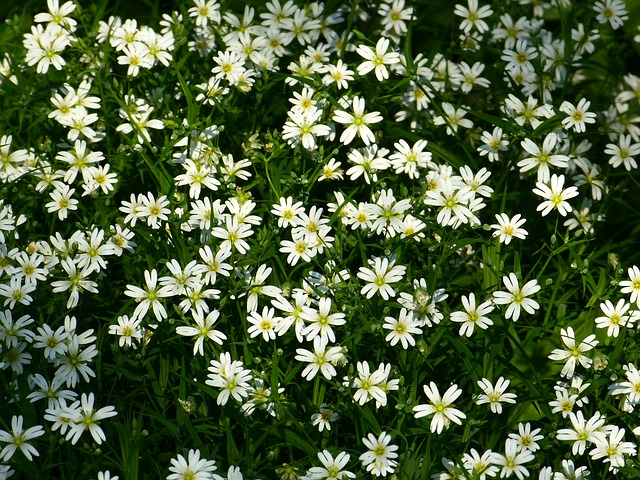 |  |  |  |  |
 |  |  |
Common Chickweed
is an annual plant with a spike-shaped branched root and a cylindrical, upright, branched stem, 10-30 cm tall. The leaves are arranged opposite to the usual direction, ovoid with a pointed end, 2 cm in length and width. The lower leaves are on stems, the upper ones are sessile. The flowers are white, placed on flower stalks, each of the five petals divided into two parts.
The plant blooms from May to September, the fruits ripen in August-September. Due to its long flowering period, the ar plant can be considered an excellent honey plant. The fruits are seed pods, with many bean-shaped or rounded, brown seeds. One plant can produce up to 15,000 seeds, which remain viable for 2-5 years. That is why this plant is especially loved by every gardener.
This plant can also be used to determine what the weather will be like. The
common Chickweed
is very sensitive to changes in humidity and temperature, so if this plant has not raised and opened its flower by nine o'clock in the morning, then you can wait for rain during the day. The plant is dried by spreading it on fine sieves or paper in a 3-5 cm thick layer, as usual in a shaded and well-ventilated place. The plant can also be dried in forced dryers, not exceeding the temperature of 40-50C. If you dry
common Chickweed
for a long time and at high temperatures, it will lose any medicinal value. After drying, the plant is crushed and stored in paper bags or glass jars. Normal sirloin is stored for no longer than one year.
100 grams of
common Chickweed
contains 23 mg of carotene, 114 mg of vitamin C, 44 mg of vitamin E, vitamin K, as well as trace elements - magnesium, copper, potassium, chlorine, cobalt, selenium, silicon and iron. The plant also contains tannins, triterpene saponins, sinapic acid, aliphatic alcohols, organic acids, alkaloids, lipids, flavonoids (saponaretin and vitexin), resins and essential oil.
Medicinal properties
Thanks to the vitamins and other components present in the normal direction, it is perfectly useful as an anti-inflammatory, immunostimulating, wound-healing and regenerating agent. It also has mild laxative, choleretic and diuretic properties.
It is believed that thanks to the flavonoids and vitamin C, E present in the plant, it has coronary vasodilating and hypotensive properties. In addition, it has a beneficial effect on the functioning of the heart by increasing blood flow to it. These properties of the plant can be used to prevent exacerbations of angina pectoris.
Vitamin K improves blood coagulation and, like other plants containing vitamin K, can be used as a means of stopping bleeding. In addition, common sow can be used to enhance lactation.
In folk medicine, this plant has been known for a long time and is used as a pain reliever, wound healing, antiseptic, antihistamine, expectorant, tonic, hypotensive, diuretic, antihypoxic agent.
In the folk medicine of various countries, the
common Chickweed
is used to treat hemorrhoids, bleeding, coughing up blood, heart pathologies, kidney, liver, lung, and skin diseases. The plant helps to remove edema of the legs. The plant also has anti-tumor properties and can be safely used in mixtures with other plants intended for complex therapy, for the elimination of neoplasms.
The
common Chickweed
is used as a preventive measure for hyperthyroidism, atherosclerosis, osteochondrosis, cirrhosis, scurvy, cystitis, anemia and eye diseases. In all these cases, you can use both infusions, decoctions, extracts, and fresh juice of this plant.
